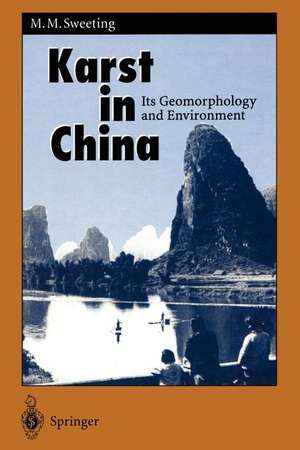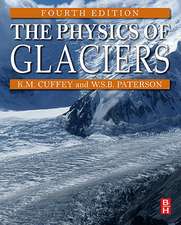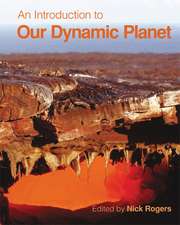Karst in China: Its Geomorphology and Environment: Springer Series in Physical Environment, cartea 15
Autor Marjorie M. Sweetingen Limba Engleză Paperback – 27 dec 2011
Preț: 639.59 lei
Preț vechi: 752.45 lei
-15% Nou
Puncte Express: 959
Preț estimativ în valută:
122.38€ • 127.79$ • 101.06£
122.38€ • 127.79$ • 101.06£
Carte tipărită la comandă
Livrare economică 15-29 aprilie
Preluare comenzi: 021 569.72.76
Specificații
ISBN-13: 9783642795220
ISBN-10: 3642795226
Pagini: 280
Ilustrații: XII, 265 p.
Dimensiuni: 155 x 235 x 15 mm
Greutate: 0.4 kg
Ediția:Softcover reprint of the original 1st ed. 1995
Editura: Springer Berlin, Heidelberg
Colecția Springer
Seria Springer Series in Physical Environment
Locul publicării:Berlin, Heidelberg, Germany
ISBN-10: 3642795226
Pagini: 280
Ilustrații: XII, 265 p.
Dimensiuni: 155 x 235 x 15 mm
Greutate: 0.4 kg
Ediția:Softcover reprint of the original 1st ed. 1995
Editura: Springer Berlin, Heidelberg
Colecția Springer
Seria Springer Series in Physical Environment
Locul publicării:Berlin, Heidelberg, Germany
Public țintă
ResearchCuprins
1 The Physical Context of Karst in China.- 1.1 The General Physical Setting.- 1.2 The Distribution and Nature of Carbonate Rocks in China.- 1.3 Tectonic Controls.- 1.4 Present-Day Climatic Controls.- 1.5 The Importance of Quaternary Climatic Change.- 1.6 The Distinctive Character of the Chinese Karst Environment.- 2 The Significance and History of Karst Studies in China.- 2.1 Western Knowledge of Karst in China.- 2.2 The History of Development of Karst Studies in China.- 2.3 The Resources and Attitudes to Karst Science in China.- 3 Karst Terminology and Karst Types in China.- 3.1 Karst Terminology.- 3.2 Karst Types.- 3.3 The Main Types of Chinese Karst.- 4 The Guilin Karst.- 4.1 Introduction.- 4.2 Peak Forest (Fenglin).- 4.3 The Peak Cluster (Fengcong).- 4.4 Age and Origin of the Guilin Karst.- 5 The Cone Karsts of Guizhou.- 5.1 The Cone Karst of Shuicheng.- 5.2 The Canyons of Guizhou.- 5.3 The Caves of Guizhou.- 5.4 The Slope Zone of Maolan.- 5.5 The Age and Origin of the Karst in Guizhou.- 6 The Karsts of Yunnan.- 6.1 Introduction.- 6.2 Conclusions on the Karst of Yunnan.- 7 Karst in Other Parts of South China.- 7.1 Karst in Southern and Western Guangxi.- 7.2 Karst in Hunan and Hubei and the Changjiang Gorges.- 7.3 Karst in the Lower Changjiang Region.- 7.4 Conclusions on the Karst of South China.- 8 The Karsts of North China.- 8.1 Introduction.- 8.2 Karst in the Qinling Mountains.- 8.3 The Shanxi Plateau.- 8.4 The Karst of Shandong.- 8.5 The Karst of the Zhoukoudian and Xishan Areas, SW of Beijing and Other Hilly Areas near Beijing.- 8.6 Karsts in NE China.- 8.7 Deep or Buried Block Mountain Karst in N China.- 8.8 Conclusions on the Karsts of N China.- 9 High Altitude Karst: The High Mountain Karst of West Sichuan.- 9.1 The High Mountain Karst of West Sichuan.- 10 The Karst of Tibet and Other Parts of Chinese Central Asia.- 10.1 Introduction.- 10.2 The General Context of Karst of Tibet.- 10.3 Chemical Features of Karst Groundwaters in Tibet.- 10.4 Surface Karst Features.- 10.5 Caves and Cave Sediments.- 10.6 Some Conclusions on the Tibetan Karst.- 10.7 The Salt Karst of the Qaidam Depression.- 10.8 Conclusions on the Karst in Tibet and Chinese Central Asia.- 11 Karst Hydrogeology and Chemical Characteristics of the Karst Water.- 11.1 General Comments and Behaviour of Karst Water.- 11.2 Contrasts Between Karst Water in North and South China.- 11.3 Karst Water Heterogeneity.- 11.4 Epikarstic Water.- 11.5 The Chemical Quality of the Karst Water.- 11.6 Conclusion.- 12 The Position of China in World Karst Studies.- 12.1 Geological Influences.- 12.2 Physiographical Influences.- 12.3 Climatic Influences.- 12.4 Influences of the Quaternary Period.- 12.5 Influences of Land Exploitation.- References.





























